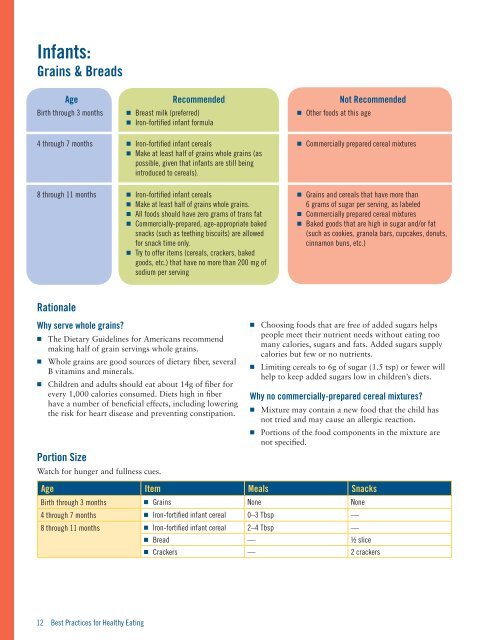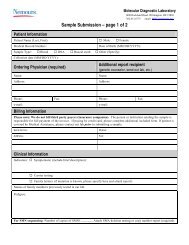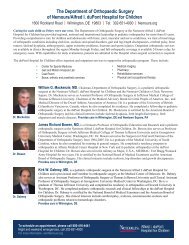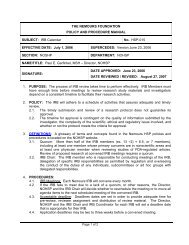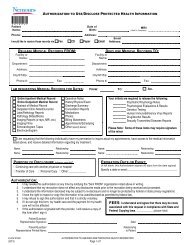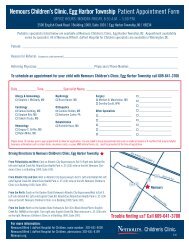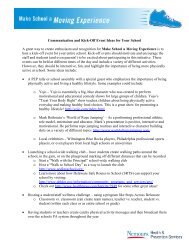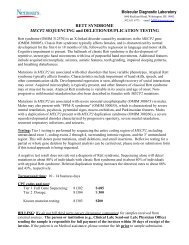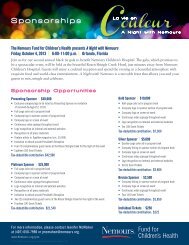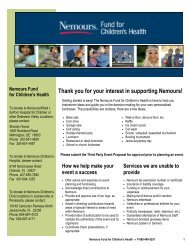Best Practices for Healthy Eating Guide - Nemours
Best Practices for Healthy Eating Guide - Nemours
Best Practices for Healthy Eating Guide - Nemours
You also want an ePaper? Increase the reach of your titles
YUMPU automatically turns print PDFs into web optimized ePapers that Google loves.
Infants:<br />
Grains & Breads<br />
Age Recommended Not Recommended<br />
Birth through 3 months n Breast milk (preferred)<br />
n Other foods at this age<br />
n Iron-<strong>for</strong>tified infant <strong>for</strong>mula<br />
4 through 7 months n Iron-<strong>for</strong>tified infant cereals<br />
n Make at least half of grains whole grains (as<br />
possible, given that infants are still being<br />
introduced to cereals).<br />
n Commercially prepared cereal mixtures<br />
8 through 11 months n Iron-<strong>for</strong>tified infant cereals<br />
n Make at least half of grains whole grains.<br />
n All foods should have zero grams of trans fat<br />
n Commercially-prepared, age-appropriate baked<br />
snacks (such as teething biscuits) are allowed<br />
<strong>for</strong> snack time only.<br />
n Try to offer items (cereals, crackers, baked<br />
goods, etc.) that have no more than 200 mg of<br />
sodium per serving<br />
n Grains and cereals that have more than<br />
6 grams of sugar per serving, as labeled<br />
n Commercially prepared cereal mixtures<br />
n Baked goods that are high in sugar and/or fat<br />
(such as cookies, granola bars, cupcakes, donuts,<br />
cinnamon buns, etc.)<br />
Rationale<br />
Why serve whole grains<br />
n The Dietary <strong>Guide</strong>lines <strong>for</strong> Americans recommend<br />
making half of grain servings whole grains.<br />
n Whole grains are good sources of dietary fiber, several<br />
B vitamins and minerals.<br />
n Children and adults should eat about 14g of fiber <strong>for</strong><br />
every 1,000 calories consumed. Diets high in fiber<br />
have a number of beneficial effects, including lowering<br />
the risk <strong>for</strong> heart disease and preventing constipation.<br />
Portion Size<br />
Watch <strong>for</strong> hunger and fullness cues.<br />
n Choosing foods that are free of added sugars helps<br />
people meet their nutrient needs without eating too<br />
many calories, sugars and fats. Added sugars supply<br />
calories but few or no nutrients.<br />
n Limiting cereals to 6g of sugar (1.5 tsp) or fewer will<br />
help to keep added sugars low in children’s diets.<br />
Why no commercially-prepared cereal mixtures<br />
n Mixture may contain a new food that the child has<br />
not tried and may cause an allergic reaction.<br />
n Portions of the food components in the mixture are<br />
not specified.<br />
Age Item Meals Snacks<br />
Birth through 3 months n Grains None None<br />
4 through 7 months n Iron-<strong>for</strong>tified infant cereal 0–3 Tbsp —<br />
8 through 11 months n Iron-<strong>for</strong>tified infant cereal 2–4 Tbsp —<br />
n Bread — ½ slice<br />
n Crackers — 2 crackers<br />
12 <strong>Best</strong> <strong>Practices</strong> <strong>for</strong> <strong>Healthy</strong> <strong>Eating</strong>


